The only thing more fun than rolling for a random magic item in the Dungeon Master’s Guide is giving your player characters an original one you created. Magic items are the most popular element of fifth edition D&D for designers and dungeon masters to create from scratch. At the time of writing this article there were nearly 6,000 homebrew magic items in D&D Beyond.
Magic items are also one of the easiest pieces of the game to make. The simple reason: magic items can do anything you want them to do and do not need to be balanced (though beware making them too powerful can make your game go haywire). Fifth edition D&D’s bounded accuracy system doesn’t account for players getting magic items, so it’s up to you how much extra power you want to give the characters.
Before You Start, Ask the Important Questions
Before you begin to design any new element of the game, don’t forget to ask these three questions, the importance of which are discussed in the first Design Workshop article:
- What do I want to make?
- Does my creation already exist as official D&D content?
- Can I reskin or tweak another creation to suit my needs?
If the item you’re considering designing doesn’t already exist and can’t be built by tweaking an existing magic item, it’s time to design our own.
Designing Magic Items
The Dungeon Master’s Guide provides guidelines for magic item creation, which are a good start. I’ll expand on what’s provided. All magic items have the following components you need to design:
- Item category
- Story and physical description
- Mechanical description
- Rarity
- Attunement
Building your magic item in D&D Beyond makes life easy. The application breaks down a magic item’s elements in an easy-to-use form. Select ITEMS > CREATE A MAGIC ITEM from the D&D Beyond homepage and click CREATE FROM SCRATCH to get started filling in the information for your creation.
I designed a set of three magic items for this article: stoneguard armor, stonecutter axe, and stoneshaper ring. I’ll show you how I designed each step-by-step.
Step 1. Item Category
There’s no mystery about this step. Is your item armor, a potion, a ring, a rod, a scroll, a staff, a wand, a weapon, or a wondrous item? (Wondrous items are magic items that do not fit into another category, including clothing, gemstones, musical instruments, etc.)
In D&D Beyond, note your item’s base type: armor, item, or weapon, then note the magic item type, armor type and details, or the weapon type as pictured in the screenshots. You only need to fill in your armor’s Dex bonus, Str requirement, and Stealth check if those elements are different than the base armor.
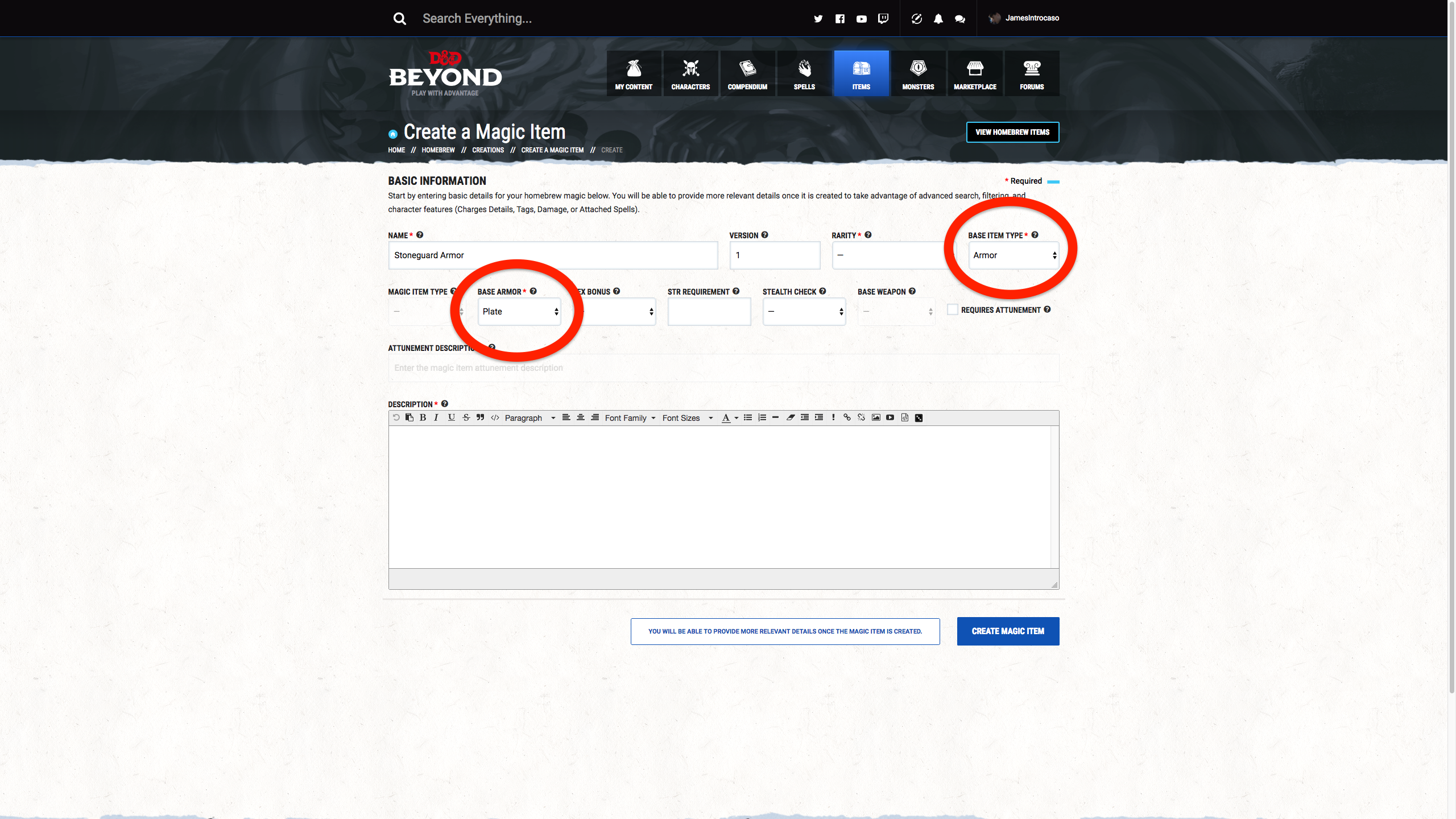
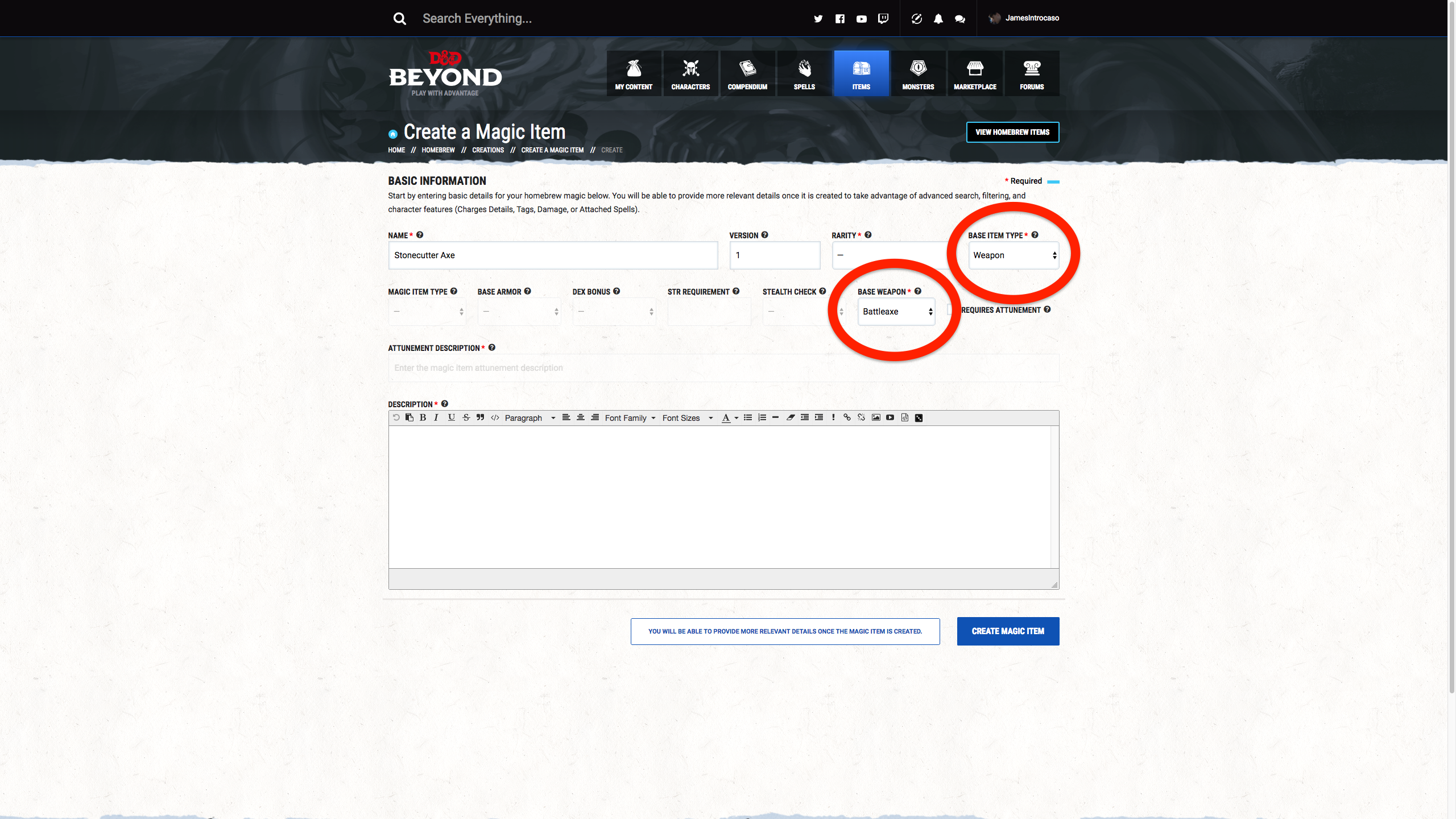
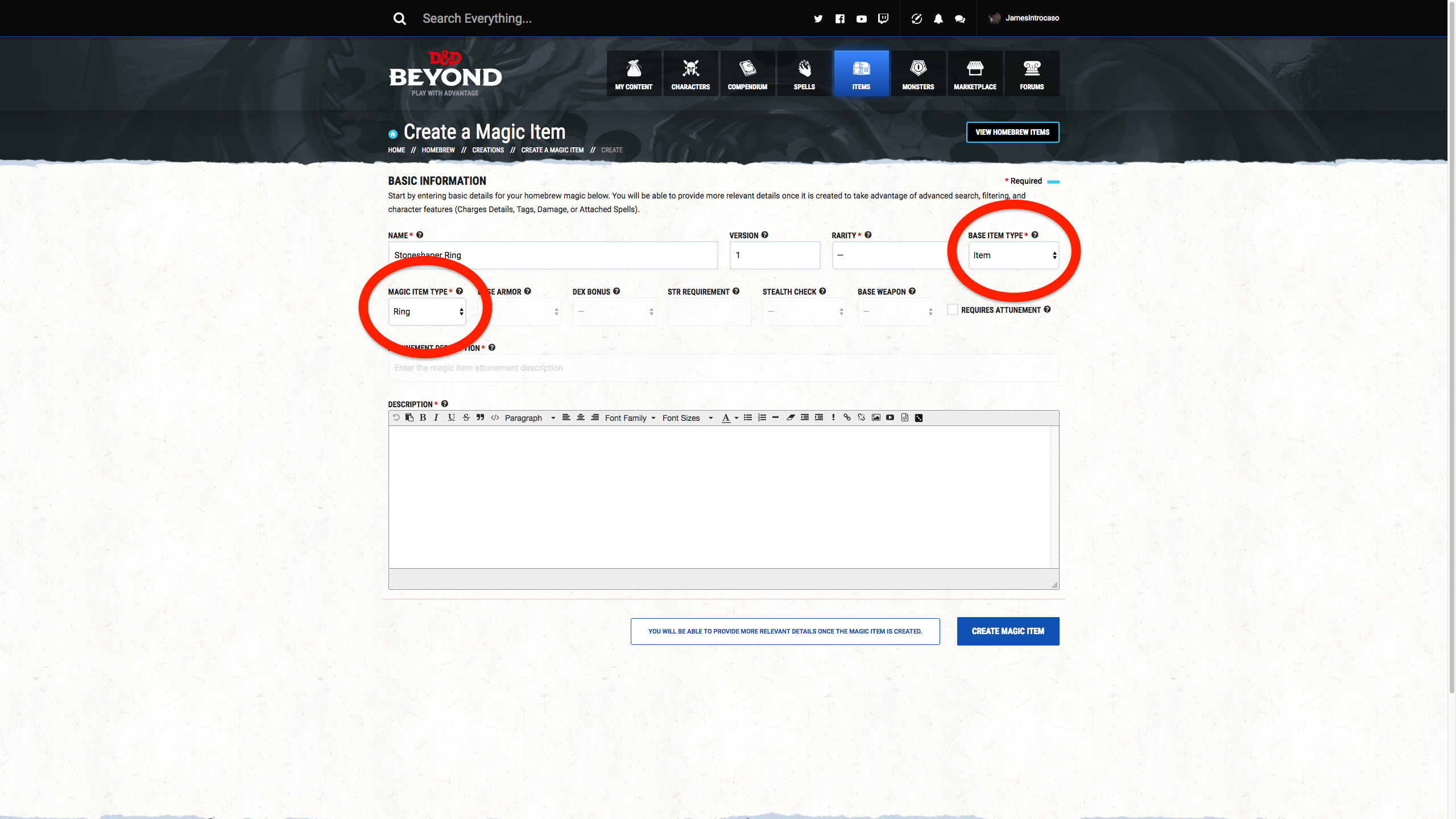
Step 2. Story and Physical Description
Many items have a single sentence at the beginning of their description that tells the reader what the item looks like. If the item’s history and narrative are significant (like moonblade), you can add as much story information as you like. I recommend putting your story information first followed by your item’s physical description, especially if both require more than a few sentences.
- The opening for stoneguard armor is Mountain dwarf masons and wizards crafted this armor to wear while defending their cities from invading duergar. This suit of plate armor consists of interlocking pieces of smooth stone and a helmet that appears to be a grinning dwarf monarch.
- The opening for stonecutter axe is Mountain dwarf masons and wizards crafted this battleaxe to wield while defending their cities from invading duergar. The axe is a single piece of stone carved with Dwarvish runes.
- The opening for stoneshaper ring is Mountain dwarf masons and wizards crafted this ring to wear while defending their cities from invading duergar. This ring is a single band of smooth stone carved with the symbol of Moradin.
Step 3. Mechanical Description
After providing a physical description of the magic item, write its mechanical description. What does your item do? The sky is the limit here, but keep in mind that items tend to thematically stick to what they do normally, just way, way better. For instance, weapons provide attack and damage bonuses, armor provides AC bonuses, and spellcasting focuses grant spells. While it would mechanically be fine for gloves to make a character move more silently, such a feature might make more sense for a pair of boots. This advice is just that: a guideline that you should feel free to break when you have good reason.
When you’re crafting your item’s mechanics, look at items, class features, spells, and feats that grant similar abilities to see how they are worded. The closer you stick to the style of D&D’s core books, the better your item plays with rules that already exists in the game. Behold the mechanics for each item I’m creating.
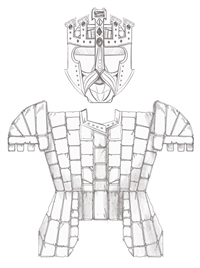
Stoneguard Armor
Mountain dwarf masons and wizards crafted this armor to wear while defending their cities from invading duergar. This suit of plate armor consists of interlocking pieces of smooth stone and a helmet that shows the face of a grinning dwarf monarch. While wearing this armor, you gain a +1 bonus to AC and darkvision out to a range of 60 feet. If you already have darkvision before wearing the armor, the range of your darkvision increases 60 feet. In addition, if you stand perfectly still while wearing this armor, your appearance is indistinguishable from a statue of an ancient dwarf monarch.
If you are attuned to the stoneguard armor and attuned to the stonecutter axe and the stoneshaper ring, the bonus to AC granted by the armor increases to +2.
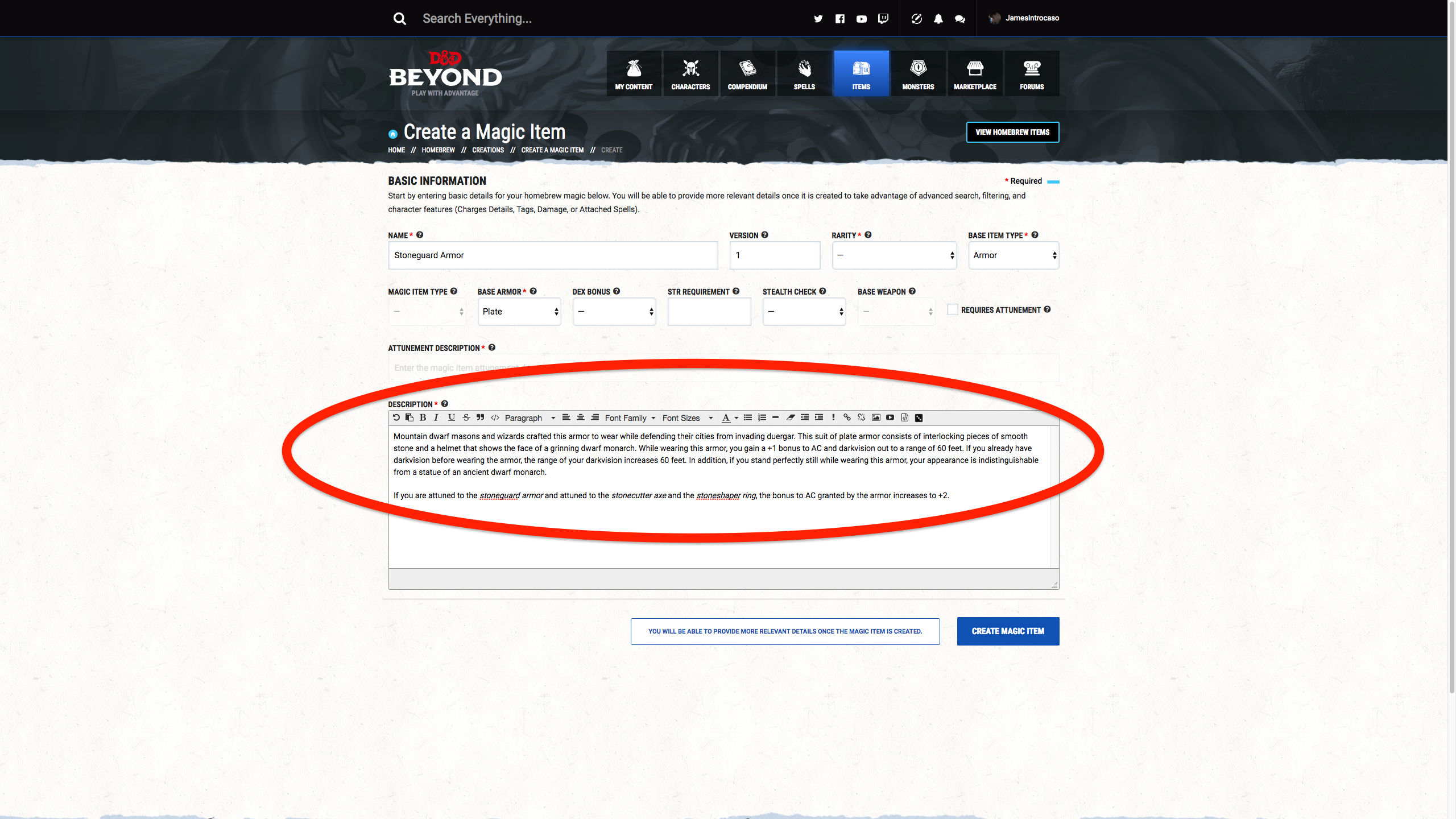
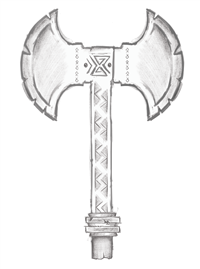
Stonecutter Axe
Mountain dwarf masons and wizards crafted this battleaxe to wield while defending their cities from invading duergar. The axe is a single piece of stone carved with Dwarvish runes. You gain a +1 bonus to attack and damage rolls made with the battleaxe. In addition, whenever you hit an object or creature made of stone or earth (such as an earth elemental or stone golem) with this weapon, you deal an extra 2d8 thunder damage to the target. If a creature takes thunder damage from this weapon, it must succeed on a DC 15 Strength saving throw or be knocked prone.
If you are attuned to the stonecutter axe and attuned to the stoneguard armor and the stoneshaper ring, the bonus to attack and damage rolls you make with this weapon increases to +2.
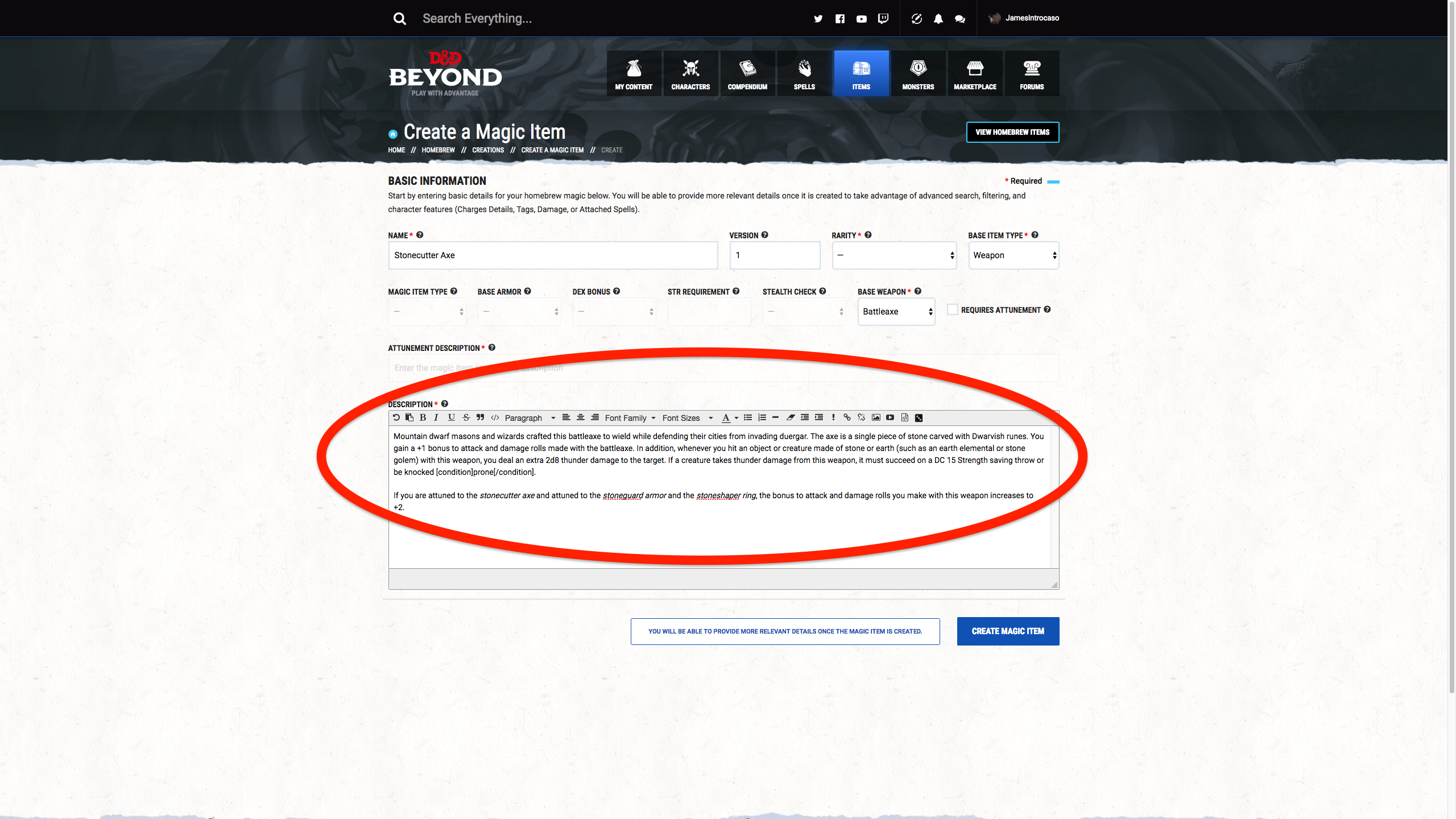
In D&D Beyond I added [ condition ] and [ /condition ] (no spaces when you actually use it) before and after the word “prone” so that the platform would recognize the fact that this word is a condition. D&D Beyond will show the condition to users when they hover over the word.

Stoneshaper Ring
Mountain dwarf masons and wizards crafted this ring to wear while defending their cities from invading duergar. This ring is a single band of smooth stone carved with the symbol of Moradin. This ring has 3 charges and it regains 1d3 expended charges daily at dawn. While wearing this ring, you can expend 1 charge to cast the following spells without needing to expend any material components: meld into stone, passwall, and transmute rock. The spell save DC for these spells is 15.
If you are attuned to the stoneshaper ring and attuned to the stoneguard armor and the stonecutter axe, the spell save DC for these spells increases to 17.
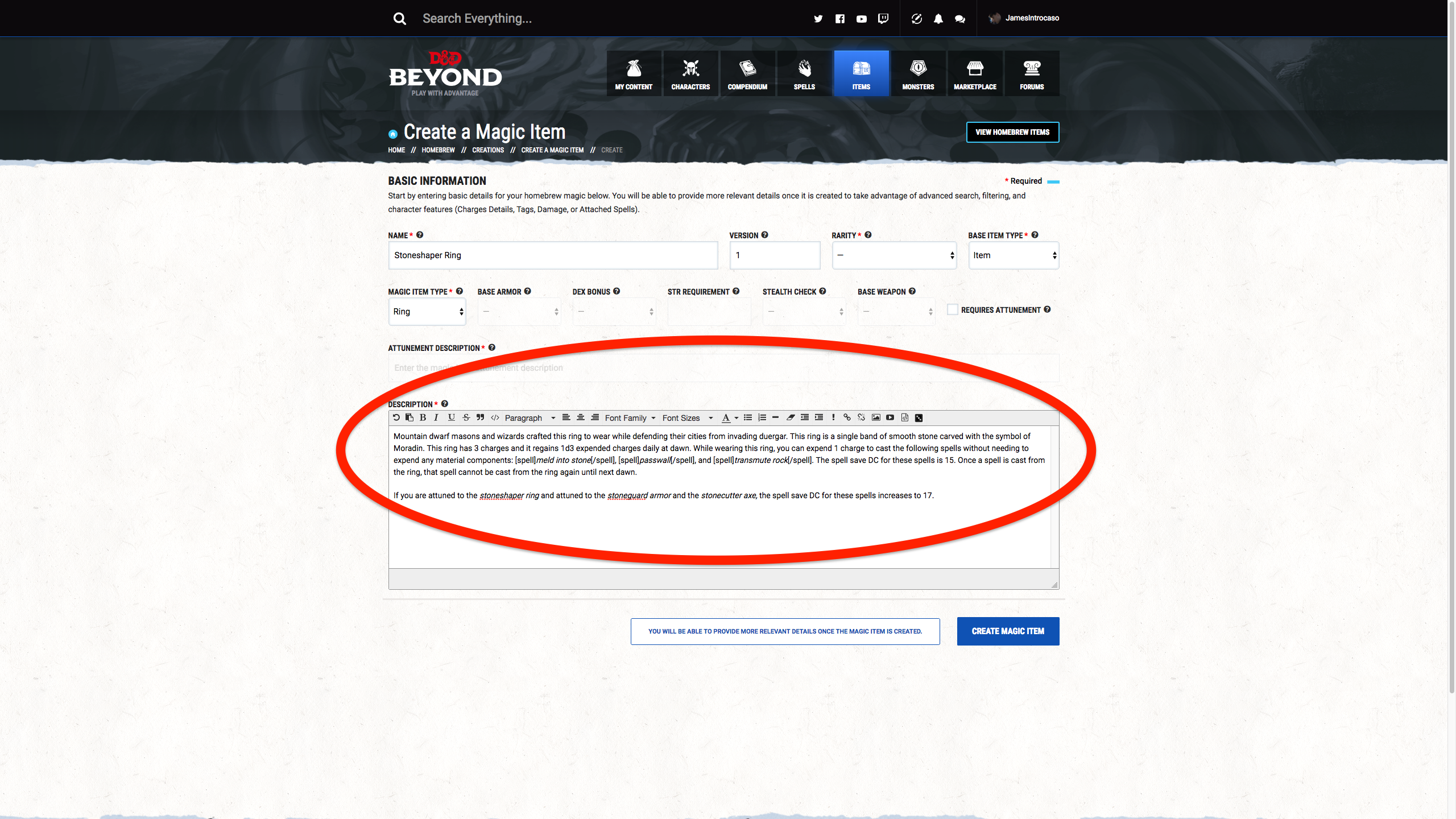
In D&D Beyond I added [ spell ] and [ /spell ] (no spaces) before and after the words “meld into stone,” “passwall,” and “transmute rock” so that the platform would recognize the fact that these phrases are spells. D&D Beyond will show the spell to users when they hover over the word.
Step 4. Rarity
The trickiest part of designing your item is its rarity, but luckily the Dungeon Master’s Guide has advice. The Magic Item Power by Rarity table is a great place to start, but it shouldn’t be the only place you look. Compare your item to similar items in the Dungeon Master’s Guide to help pinpoint rarity.
The Magic Item Power by Rarity table it says that an item that grants a +1 bonus to AC or attack rolls must be at least uncommon rarity and items that grant 5th-level spells must be at least rare. That means off the bat the +1 bonuses provided by the stoneguard armor and the stonecutter axe make those items at least uncommon. The same table reveals the stoneshaper ring is at least rare, since it grants two 5th-level spells to its wearer.
To determine the final rarity of the stoneguard armor I looked at other magic suits of armor in the Dungeon Master’s Guide. First I saw that plain old armor, +1 starts at rare, which immediately boosts the rating of my armor from uncommon to rare. Then I compared it to armor of invulnerability, demon armor, and dwarven plate to get a sense of different magic plate armor abilities compared to rarities. Stoneguard armor grants darkvision, a hiding utility, and the potential to raise its AC bonus to +2 when paired with other magic items, so I raised its rarity one more time from rare to very rare.
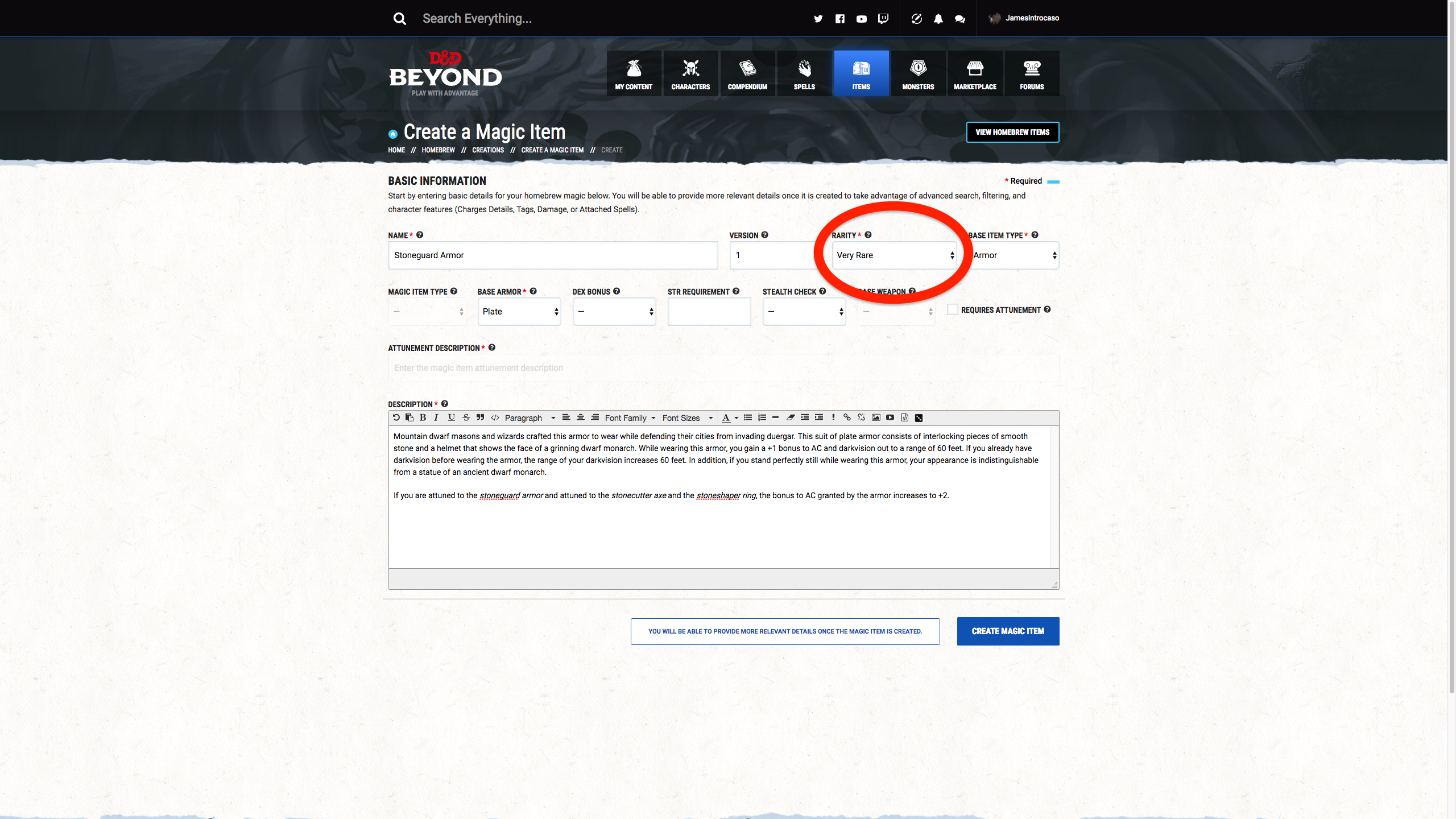
To determine the final rarity of the stonecutter axe I looked at the rarity of other magic weapons in the Dungeon Master’s Guide. I studied the berserker axe, dagger of venom, sword of sharpness, sword of vengeance, and sun blade specifically. Given the features of the stonecutter axe beyond its bonus to attack and damage rolls, I gave it a boost in rarity from uncommon to rare.
To determine the final rarity of the stoneshaper ring I looked at the rarity of all the magic rings in the Dungeon Master’s Guide. The item’s limited casting power and the fact that three of its spells are under 6th-level tracks with its already determined rare power rating, so I left it as is.
Step 5. Attunement
You need to determine if your item requires attunement. Once again the Dungeon Master’s Guide provides great advice:
- If having all the characters in a party pass an item around to gain its lasting benefits would be disruptive, the item should require attunement.
- If the item grants a bonus that other items also grant, it’s a good idea to require attunement so that characters don’t to collect too many of the other items.
- James adds: If your item is consumable (like a potion) it should not require attunement.
If you’re on the fence about attunement for your item, play it safe and go with requiring it. Many in the Dungeon Master’s Guide do. The stoneguard armor, stonecutter axe, and stoneshaper ring all require attunement because they provide benefits that would be disruptive if passed around from player to player.
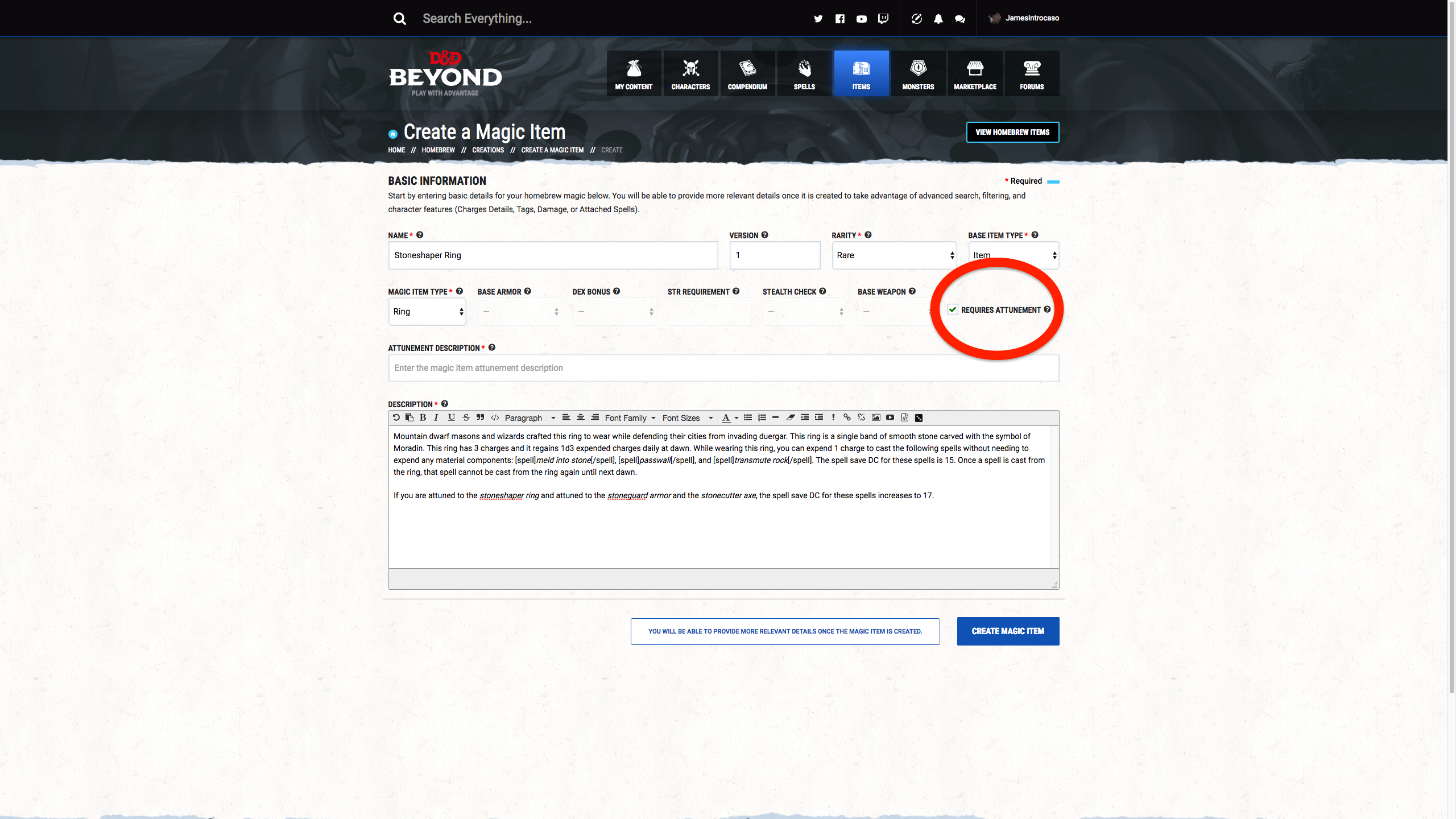
Are there any restrictions about who can attune to your items? For instance in the Dungeon Master’s Guide the staff of the woodlands requires attunement by a druid or the moonblade requires attunement by an elf or half-elf of neutral good alignment. Do whatever makes sense for your item’s story.
For the most part, staffs and wands that grant the wielder a significant number of spells require attunement by a spellcaster or a specific class that can cast the spells granted. This helps curb the items power. A staff of fire the hands of a sorcerer or wizard essentially gives the caster more spell slots. In the hands of a bard or fighter however, the item turns them into multiclass characters with access to spells they probably don’t have without the item. It’s fine if you want to design a staff that casts unlimited fireball spells to which anyone can attune, just know the consequences.
Step 6. Additional Information and Tags (D&D Beyond Only)
If you built your magic item in D&D Beyond, click CREATE MAGIC ITEM. Once you do that you can add charge information, weight (if different than the base item), a picture, tags, modifiers, conditions, and spells to your items. Uploading an image from your computer is easy. I had art for my three items done by Jackie Allenbach.

With the images uploaded, the stoneguard armor and the stonecutter axe need only tags in this section. I gave the armor the COMBAT, DECEPTION, PROTECTION, and STONE tags and the axe the BANE, COMBAT, DAMAGE, STONE, and WEAPON tags.
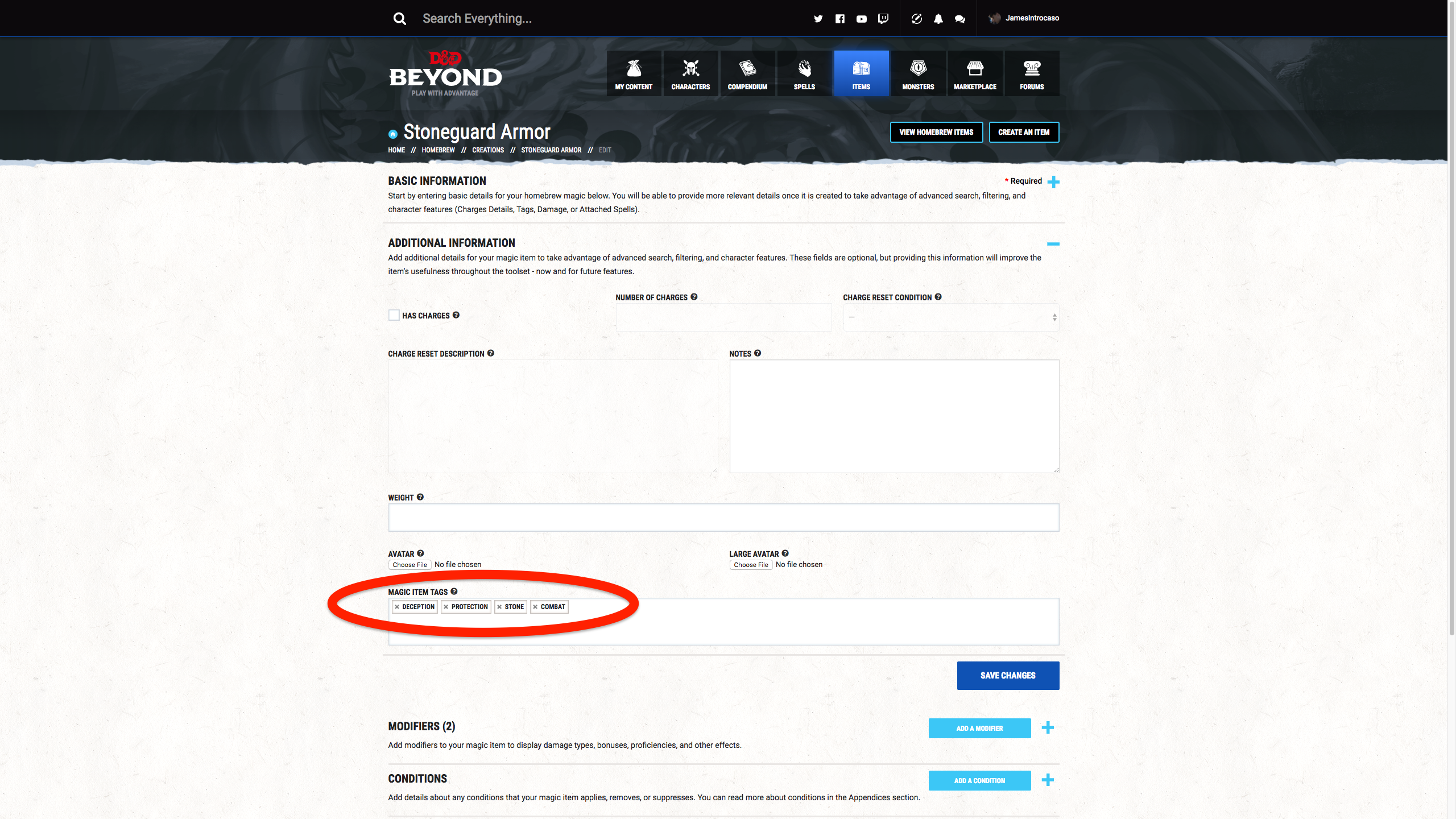
The stoneshaper ring has charges, so I filled out the proper information as shown in the screenshot. Then I gave it the CONTROL, JEWELRY, STONE, and UTILITY tags in D&D Beyond to make it easier for people to find.
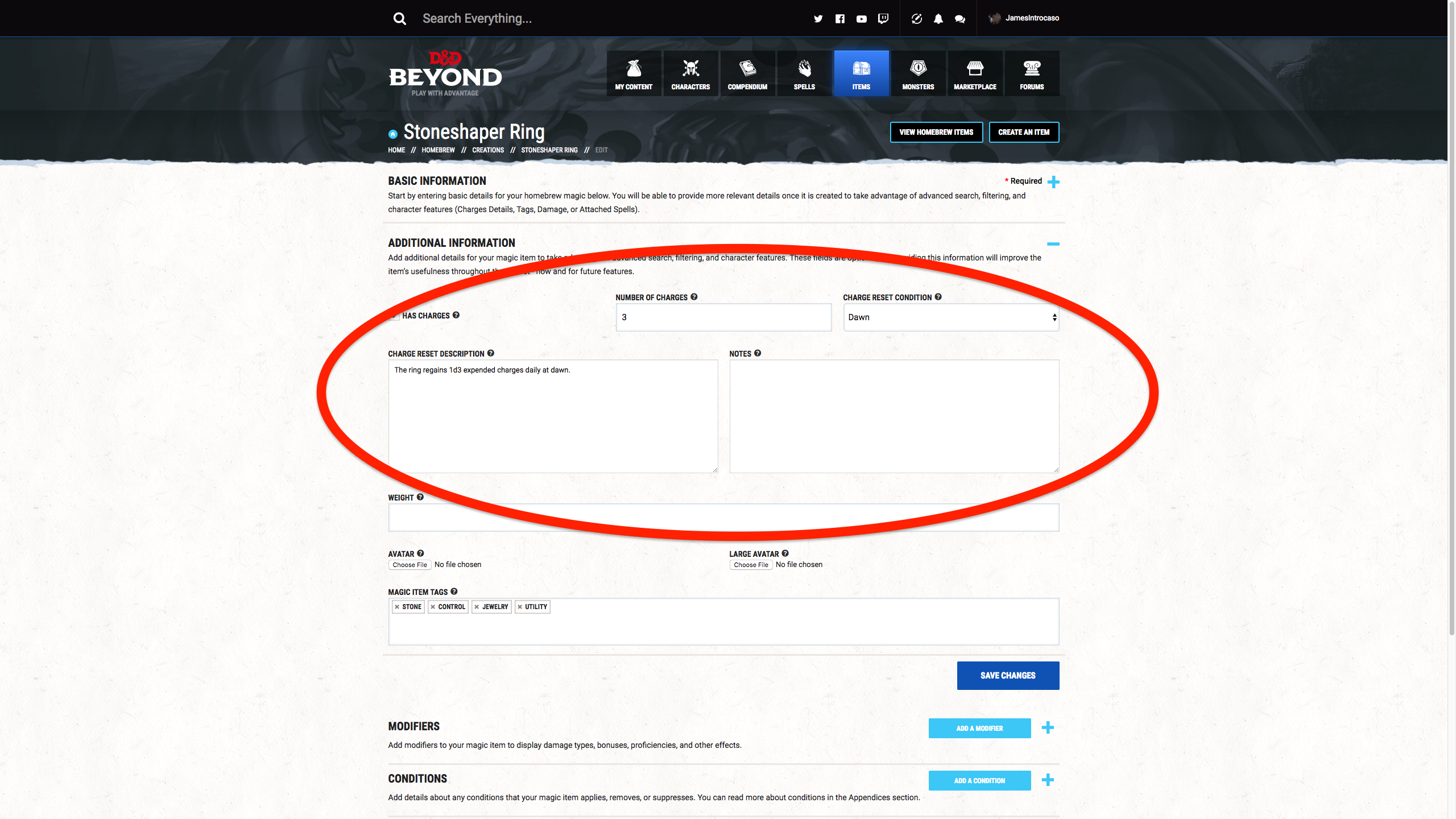
Step 7. D&D Beyond Elements (D&D Beyond Only)
Once tags are done, you should add modifiers, conditions, and spells to your item as needed. Adding this information in D&D Beyond ensures the character’s sheet updates properly when the item is added.
The stoneguard armor got a +1 AC modifier and darkvision modifier.
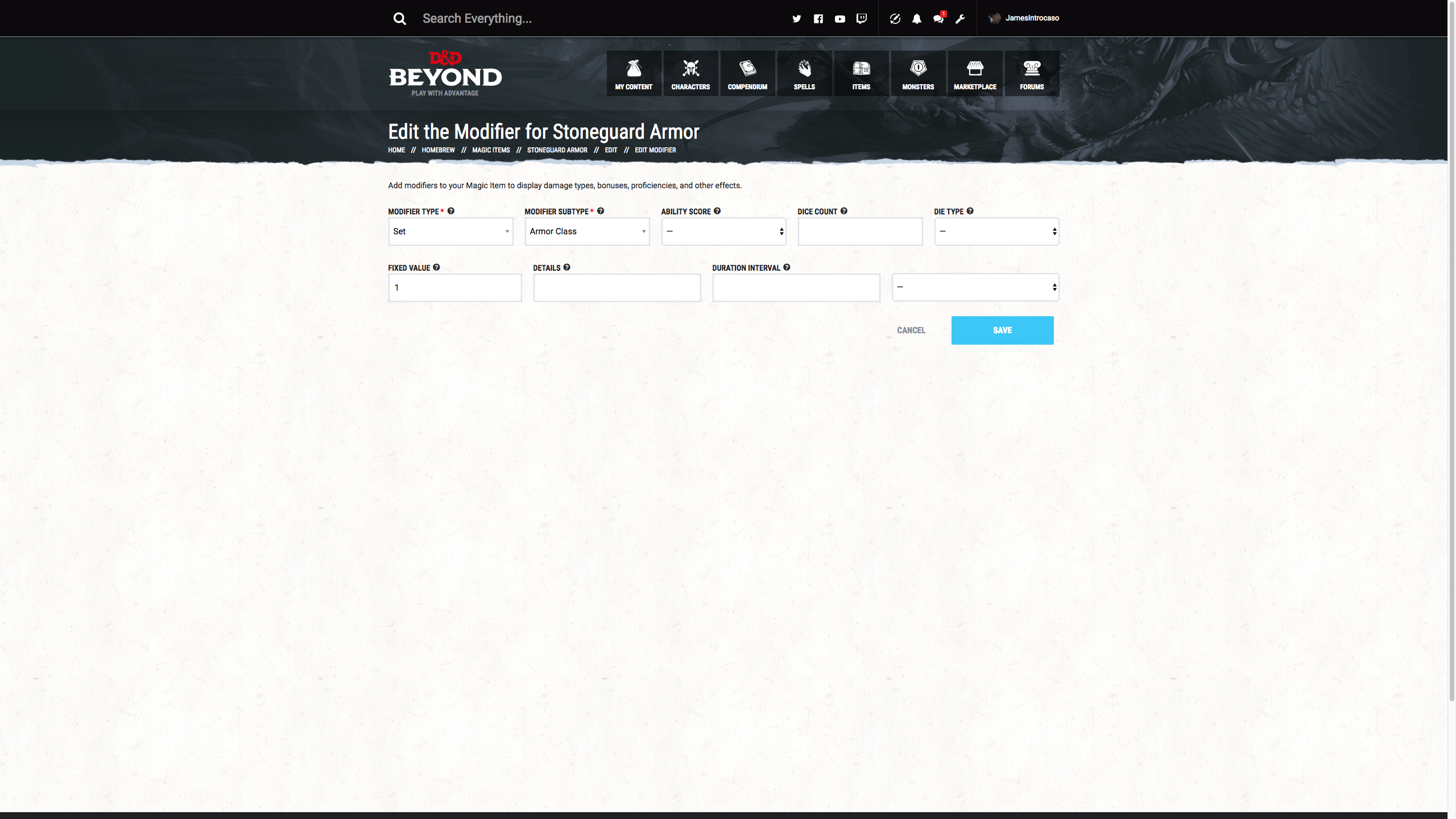
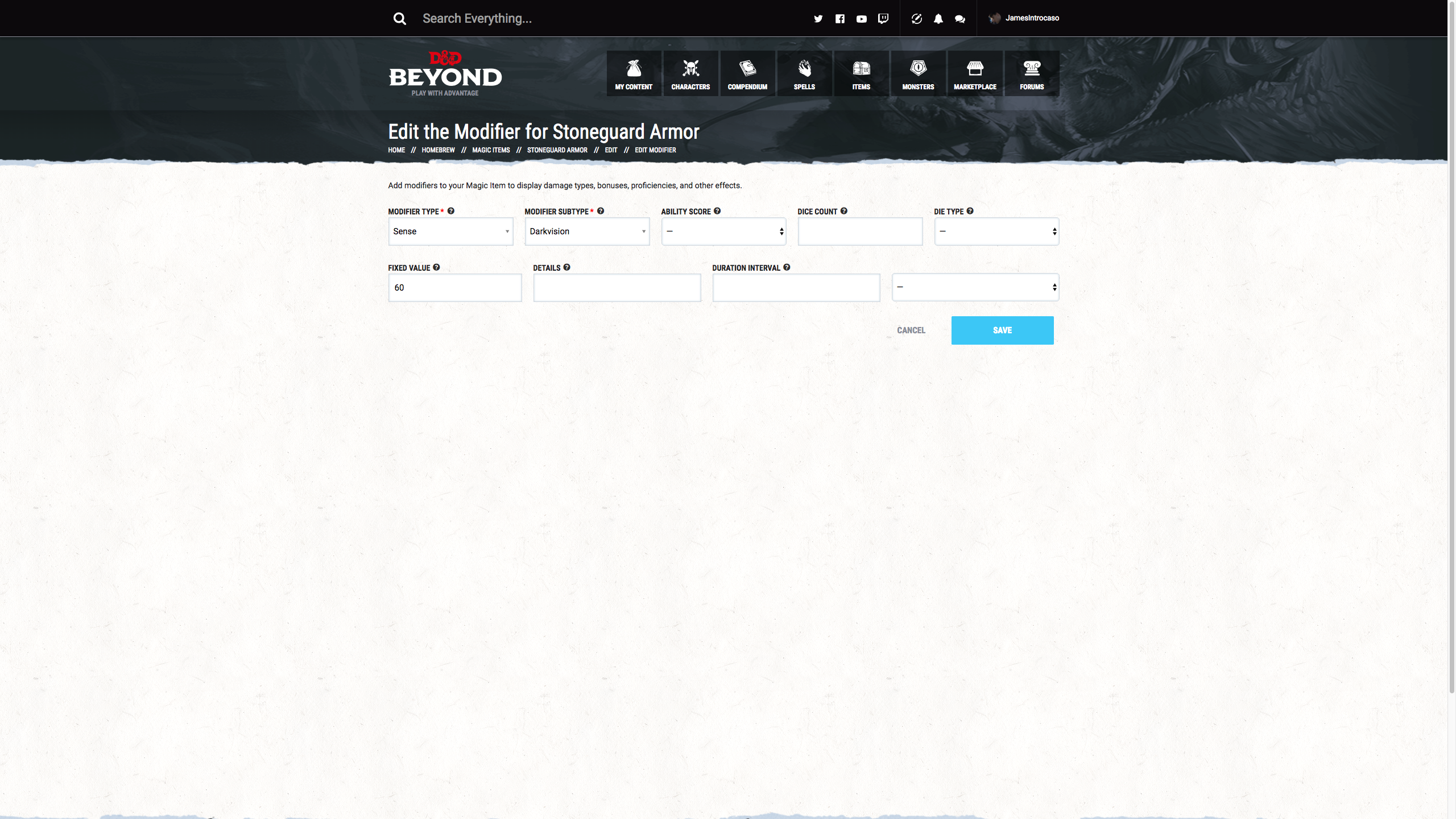
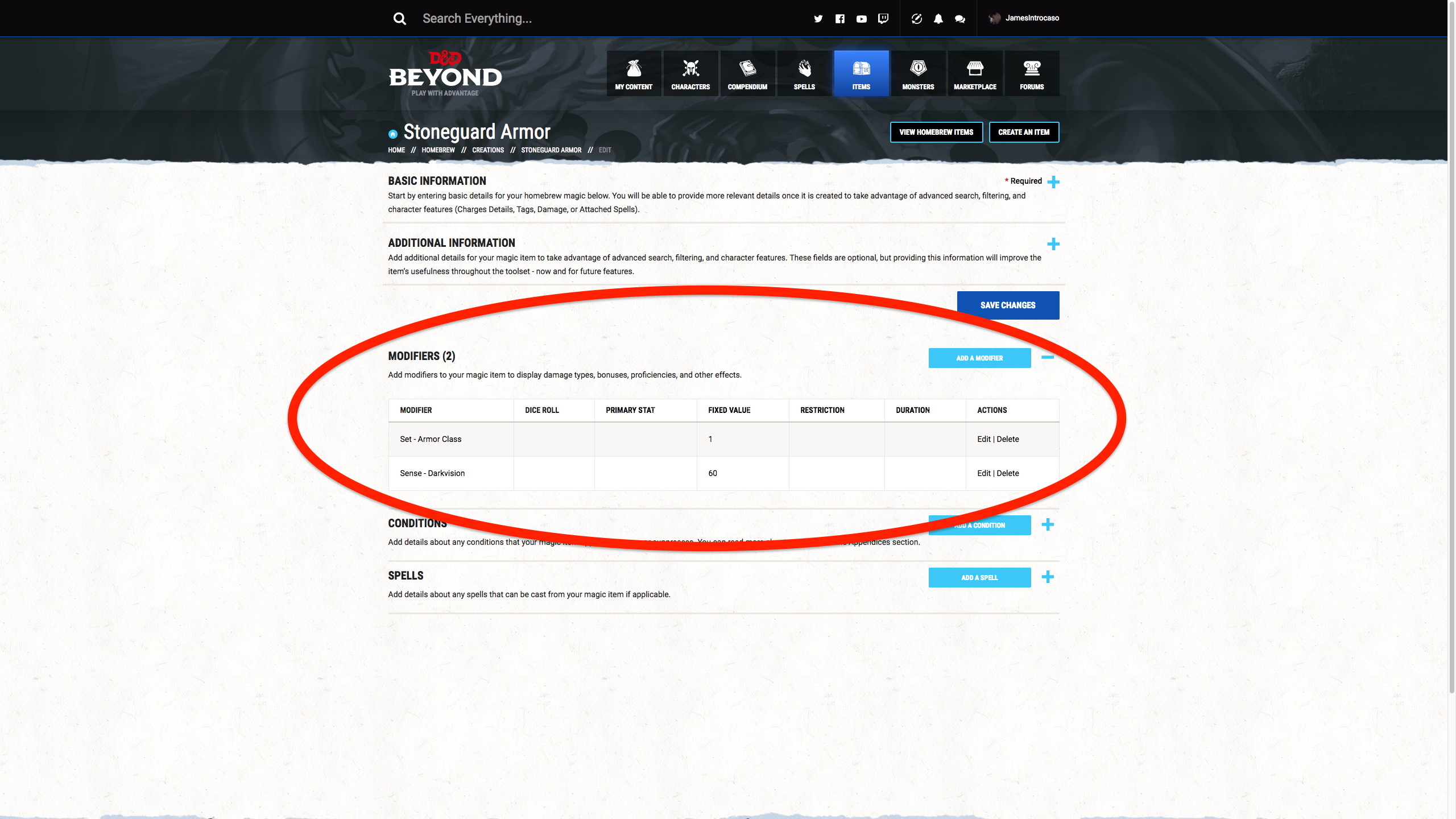
The stonecutter axe got a +1 attack and damage modifier, the extra thunder damage, and a condition modifier added for its ability to knock certain creatures prone.
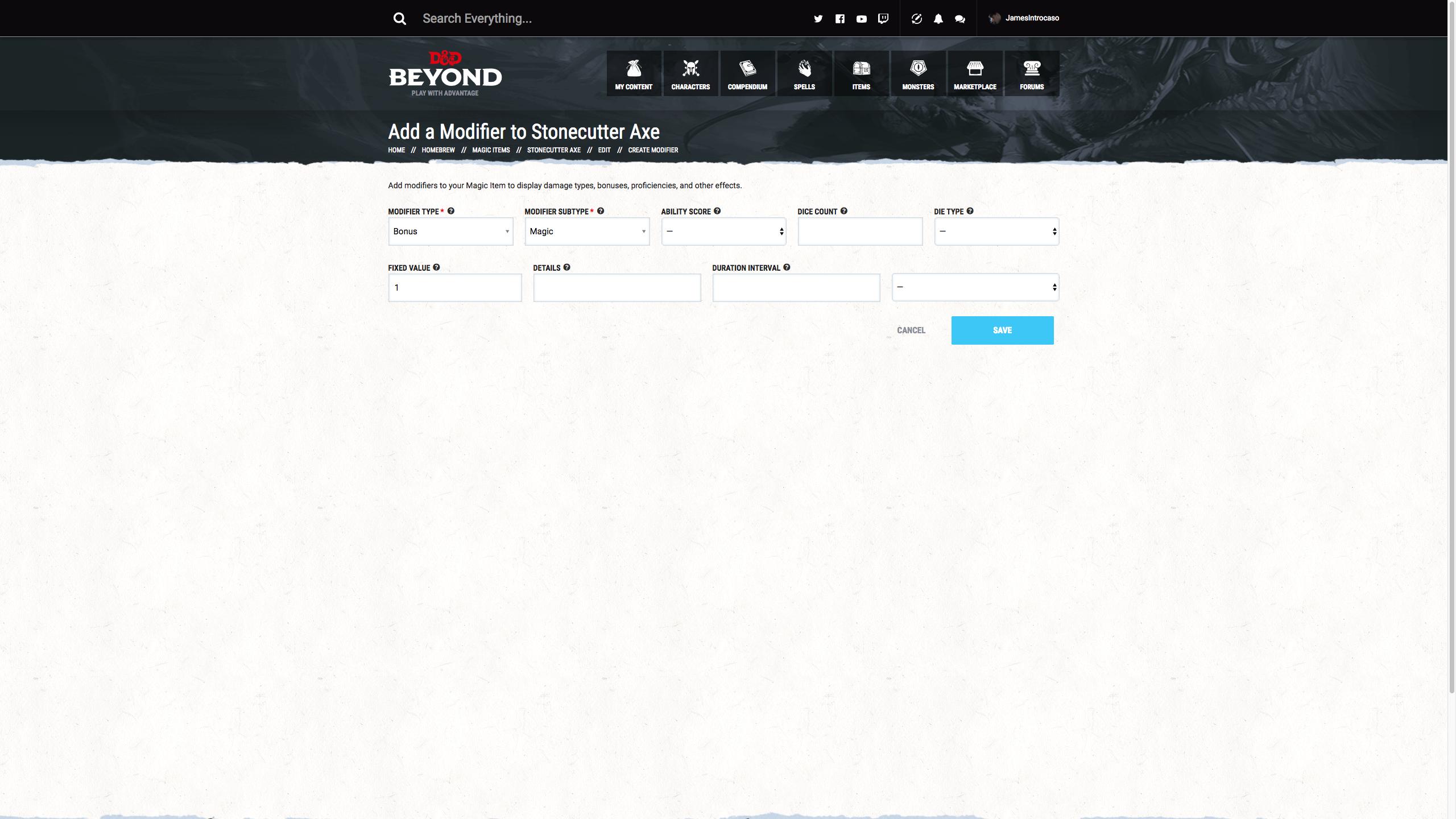
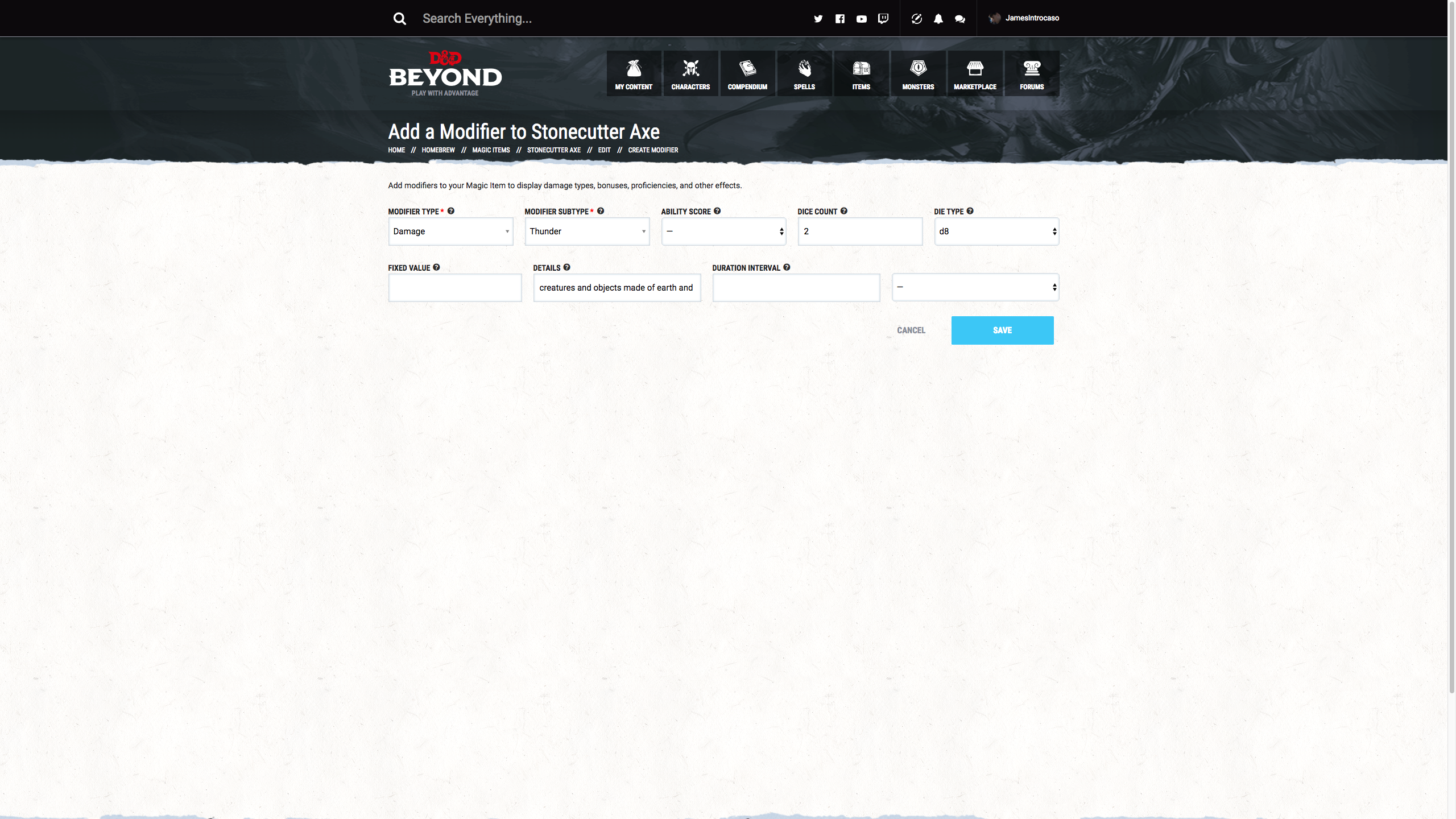
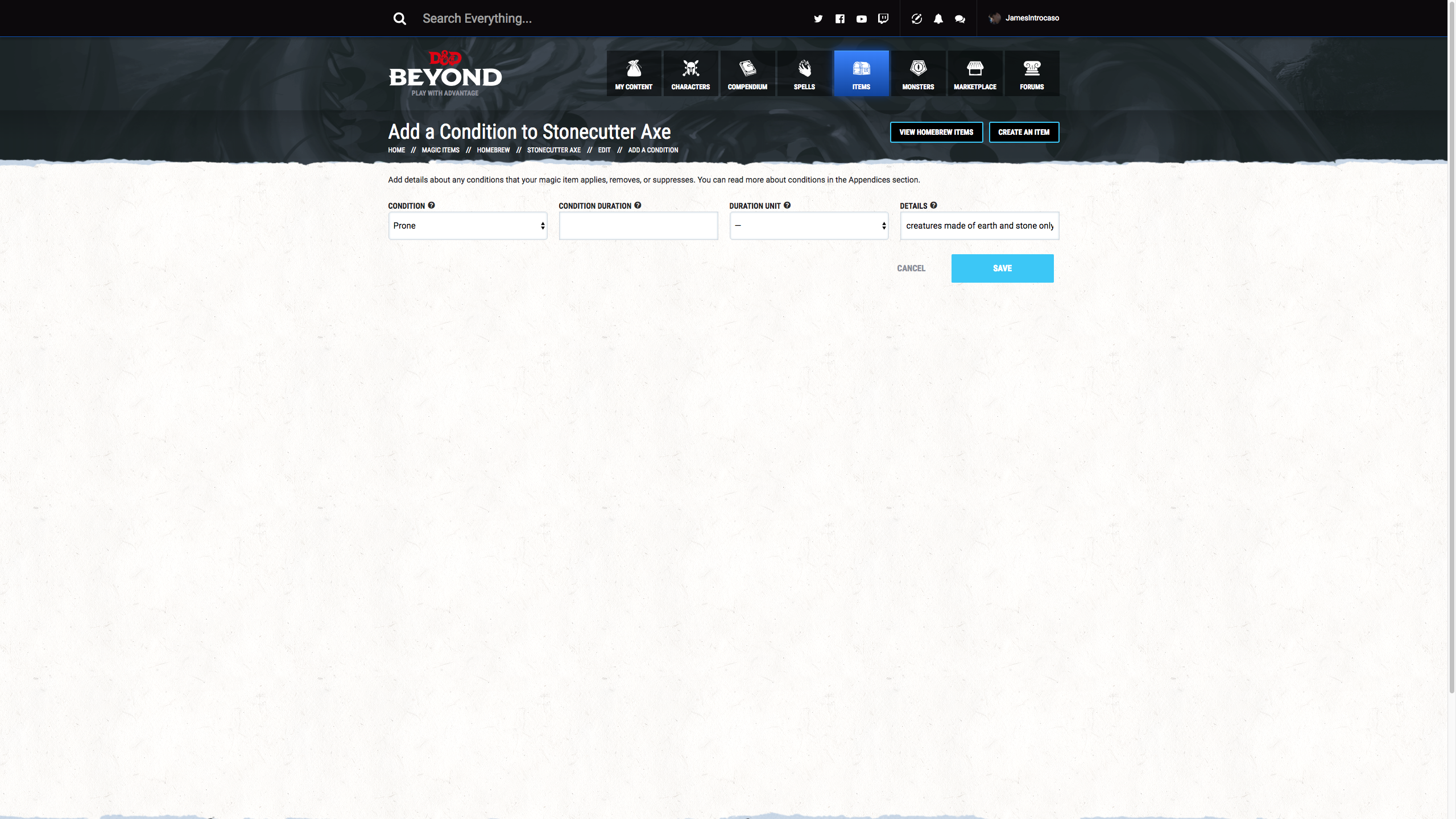
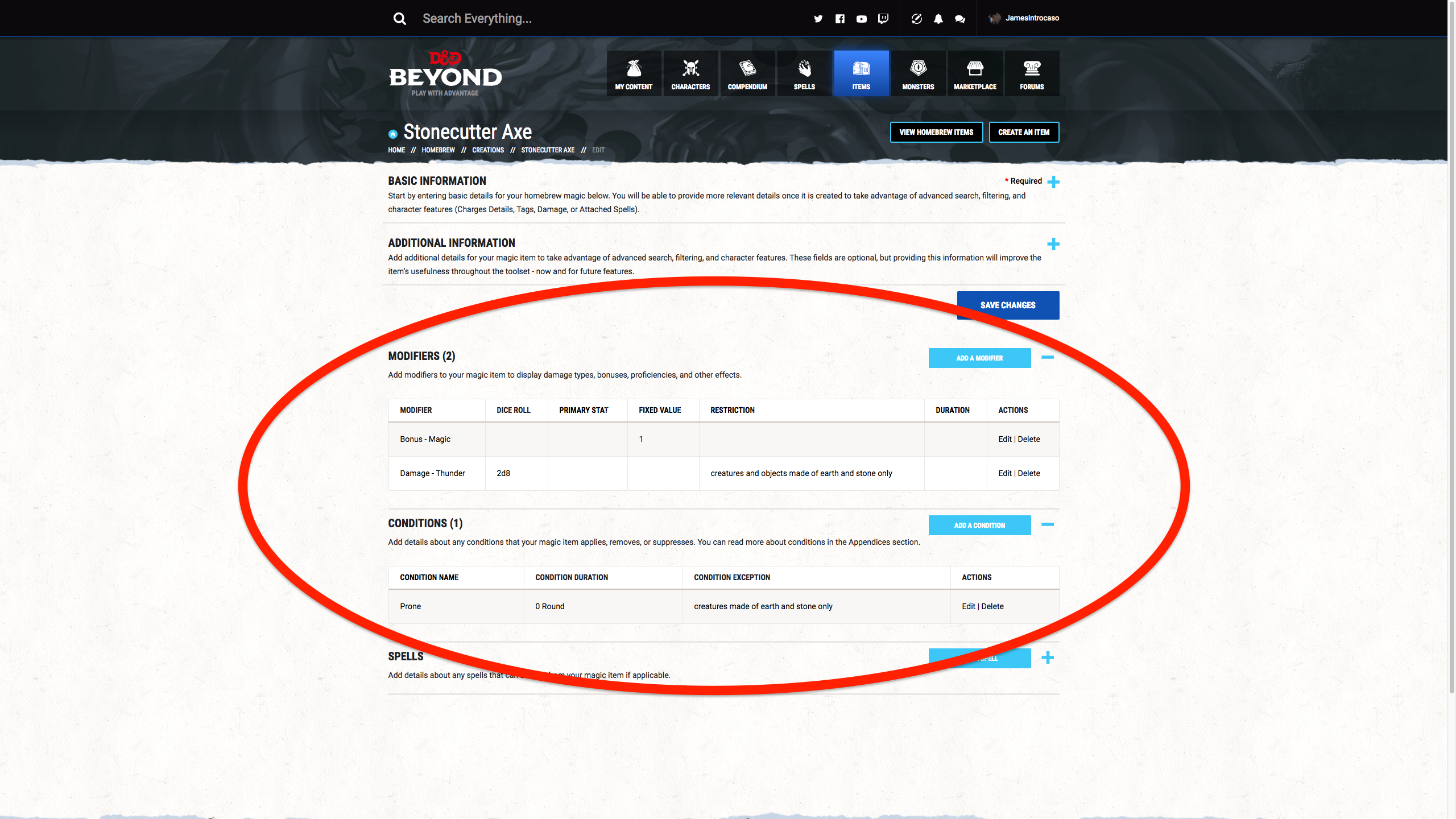
The stoneshaper ring got its three spells. Note that only transmute rock has a spell save DC, since the other spells don’t require it.
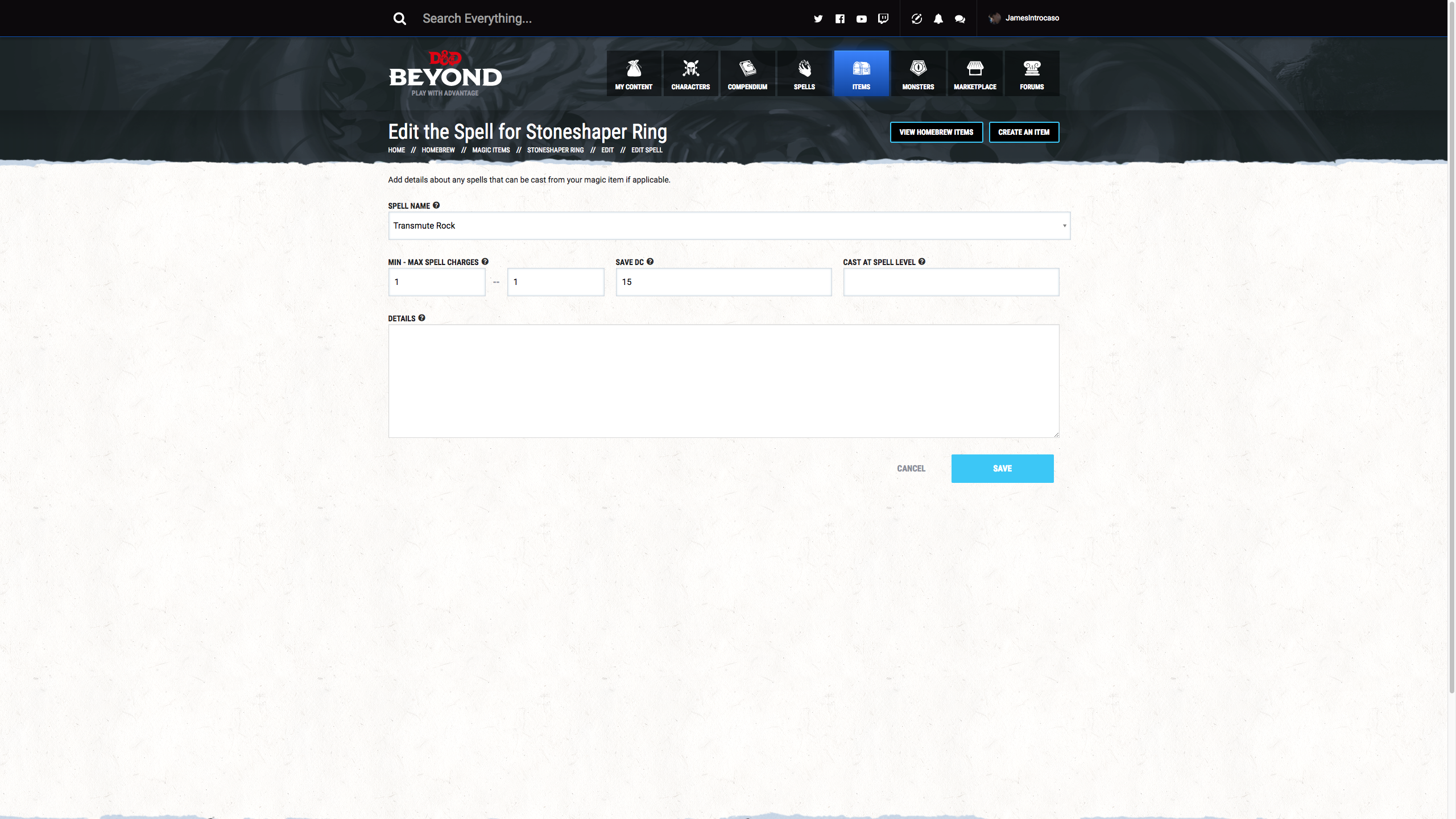
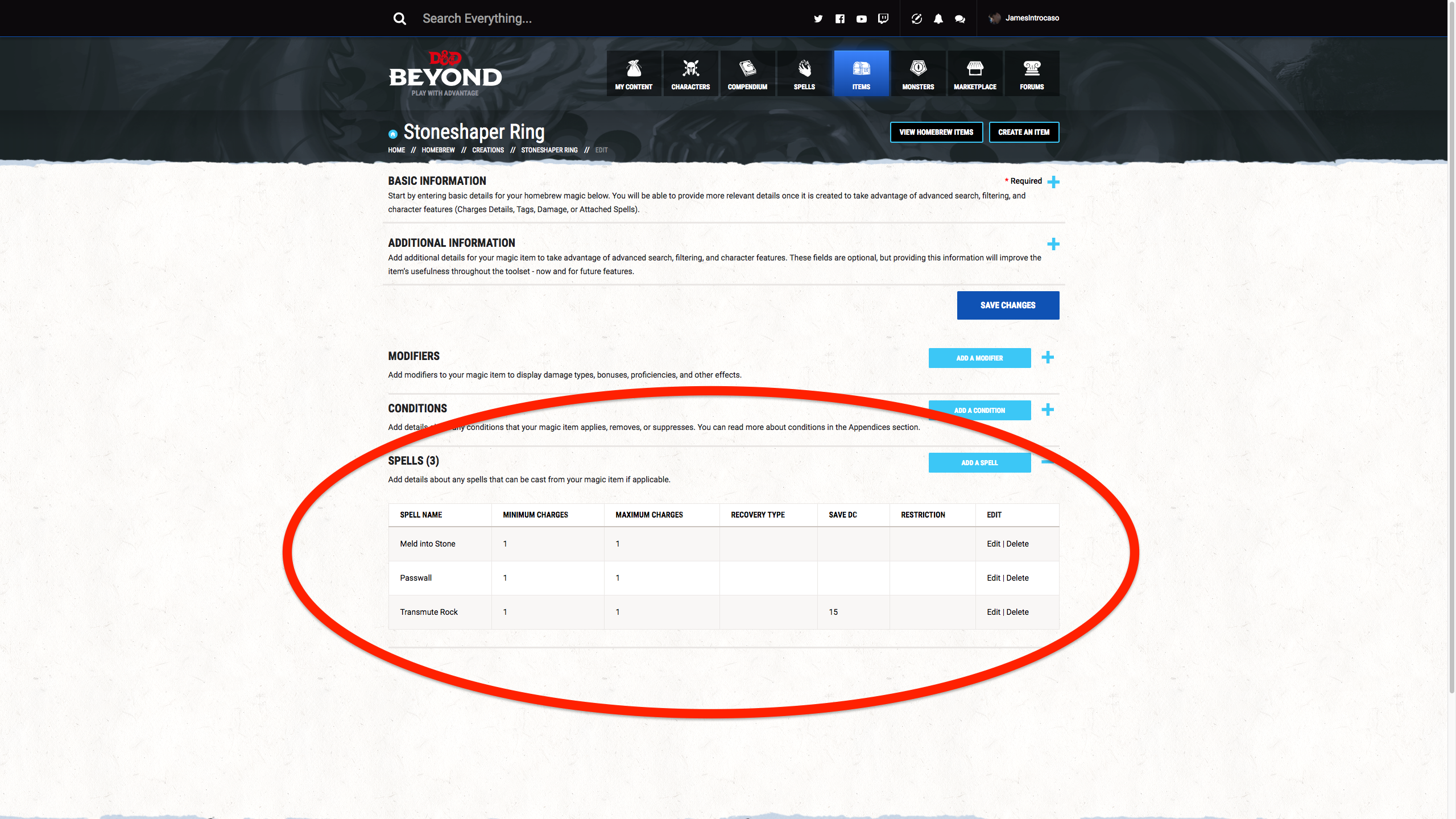
Step 8. Edit and Playtest
Now that you’ve created your magic item, give it a once over. Read it out loud and edit. Even the most experienced designers need to edit their work. Then send your work to a friend to make comments. A second pair of eyes helps you understand if the design intent of your item is coming through.
If you have the opportunity to playtest your new item, take it! Nothing is a better test of your design work than actually seeing it in action. Plus it’s a great excuse to get friends together for a game of D&D! As always give your item to someone else to use during the playtest, again to see if the design intent comes through. Change anything you think needs it after playtesting.
Step 9. Make Your Work Public
It’s time to make your work public! That means sharing the magic item with your group, posting it to a blog, putting it up for sale on the DMs Guild, or right here on D&D Beyond. To do this in D&D Beyond go to the MY CREATIONS page, select your item, and click MAKE PUBLIC. A message then appears asking if you’ve read the Public Homebrew Content Rules & Guidelines and explaining the moderation process for public content. If you’re ready to submit your item, click SUBMIT and you’ll get a moderation notice from the D&D Beyond team once your item is accepted or rejected. Make sure you actually read the guidelines. Most rejections happen because the creator hasn't followed one of the very simple guidelines, or because they're attempting to publish work they don't own or didn't create themselves. Please note that it is completely fine to keep your creation private if you intend to to only use it in your own game and do not wish to share it.
Lucky for me all three items were accepted. You can find the final versions here: stoneguard armor, stonecutter axe, and stoneshaper ring.
Go Make Stuff!
There you have it! A step-by-step process for creating a D&D magic item. I can’t wait to see what people submit to the great D&D Beyond. If your design gets posted, please share a link with me on Twitter at @JamesIntrocaso. Next time in the Design Workshop, I’ll show you how to make a new monster!
James Introcaso blogs at World Builder Blog, podcasts at Don’t Split the Podcast Network, and designs games for Wizards of the Coast, Roll20, Kobold Press, Roleplaying Tips, and more.








-
View User Profile
-
Send Message
Posted Mar 20, 2018Great article! I’ll be putting this info to good use. One criticism, though: the axe says on its page it doesn’t require attunement, but you said in the article that it does.
-
View User Profile
-
Send Message
Posted Mar 20, 2018Ah thank you! Let me see what I can do about that. It should require attunement.
-
View User Profile
-
Send Message
Posted Mar 20, 2018Very timely article. In one campaign I'm in, I've been modifying... and in another the DM is trying to work on this. One question I had about this is the Set qualities. I know there is a Set property but I'm not seeing the Set Bonuses apply when equipping the items. Is there any insight you could give there?
Oh... nevermind... since you can't attune the Axe, you can't get the bonus.
-
View User Profile
-
Send Message
Posted Mar 20, 2018Great article! I'm still a pretty new player/DM (started playing about a year ago and DM'd for the 1st time about 3 months ago.) and this article has definitely helped to enlighten me on a few things I wasn't sure about, most namely on how to determine attunement. I'm looking forward to the next article! :D
-
View User Profile
-
Send Message
Posted Mar 20, 2018-
View User Profile
-
Send Message
Posted Mar 21, 2018Great article at a great time. I was just creating some items.
But one question remains. Do/can I put the Set bonus into the items, so they are automatically added?
I mean, with the armor you put in "Set - Armor Class" 1. But shouldn't that be a bonus? Or did I get that somewhat wrong? Maybe I am misinterpreting "Set".
-
View User Profile
-
Send Message
Posted Mar 23, 2018I'm not seeing the set bonuses applying either. Neither the Axe or the Armor increase bonuses when the full set is attuned. I was thinking the "Set" option was doing it, but I'm not clear enough on how to be specific enough in the limitations of the set to the apply a bonus to a full set. There are enough options, that I would imagine it is in there... but I've found that some of these are somewhat less straightforward than I was expecting them to be. I could see "Set" being a quagmire of requirements...
-
View User Profile
-
Send Message
Posted Apr 4, 2018So question: items with multiple rarities, like wand of the war mage. It there a way to make only 1 item, but have it show up multiple times depending on the rarity? +1 uncommon, +2 rare, +3 very rare. Or do you have to create them all individually?
-
View User Profile
-
Send Message
Posted Apr 5, 2018Are you asking if you can upgrade and +1 item to a +2 or +3 item? Or are you asking if it's "within the rules" to spawn a particular item in different locations with different rarities and therefor, a better bonus? Regardless, the answer to the latter is YES! The only exception would be for "unique" items, such as Vecnas' Eye and Hand, The Sword of Kas, etc... The only thing rarities are actually a measure for, is how powerful/expensive/time consuming/rare the item is in the world or that it would be to try and create yourself. I don't wanna give any numbers since I'm not actually sure, but many of the "unique" items are going to be HEAVILY tied to the lore of D&D, so that's what you should use to determine if you want a finite number of an item in your game or not. Otherwise, individuals of the magical persuasion can be found everywhere and thus, magical items of various rarities can be found wherever you (the DM) want them to be. I would use caution when giving PC's equipment that's more and more rare tho, so as to avoid any breaking of mechanics via abuse of an items effect(s) in some way.
As for the first question I posed, you can do whatever you want as the DM. If you wanna offer the PC's the opportunity to increase the magical bonus on a magic weapon through some way, then by all means! If you do tho, I would recommend that you make it very expensive because that kind of upgrade is super strong. If I was determining the price range I'd even go so high as, like, 10,000 - 15,000gp for a +2 and double that for a +3. I'm not sure if there's an "official" ruling on this or not but that's just what I would do. :P Best of luck in your adventures. Cheers! :D
-
View User Profile
-
Send Message
Posted Apr 5, 2018Sorry I didn't clarify my question enough. When making items in the homebrew section of DnDBeyond, is there a way to make one item with multiple rarities without have to make each individual item? I know you can put "Varies" as a rarity field, but I can't figure out how to define the individual items when I do that. This isn't a question about how to play the game (though that info was useful), but how to better use the item homebrew tool of DnDBeyond.
-
View User Profile
-
Send Message
Posted Apr 5, 2018Ah, well at least I helped in some way. lol Unfortunately, I too am still experimenting with the Homebrew creation tools, so I don't have a definitive answer for you. As far as I know, if you want to actually change all the stats for the item to correspond with a different rarity, then you're only option is to duplicate the item and then manually edit the rarity and stats as if it's a separate item altogether. :P You can do this by clicking on the item in the homebrew creations tab after creating an initial version and then clicking on "create a new version" in the top right corner of the item description. :D
-
View User Profile
-
Send Message
Posted Apr 5, 2018Further you can use your initially created item as base. Just search for it in the box that pops up when you have to choose whether to start from scrap or not. Unfortunately, you can only use your own homebrew creations and not everything you added on your homebrew list. :(
-
View User Profile
-
Send Message
Posted Feb 5, 2019How do you change the modifier to dam and att from dex/str to Cha?
-
View User Profile
-
Send Message
Posted Apr 15, 2019These are great tips. More guides and references for home-brew please!
-
View User Profile
-
Send Message
Posted Jun 18, 2019Is there a list that identifies what each modifier does? I'm specifically trying to figure out which one allows a character's abilities to exceed 20.
-
View User Profile
-
Send Message
Posted Jul 29, 2019How do I change damage dies for weapons?
-
View User Profile
-
Send Message
Posted Jul 30, 2019I was never able to figure out a way to essentially "remove" the original damage die for the weapon, only add on to it with by either adding a fixed value magic bonus or by adding an additional damage die roll.
Weapon magic ax
Modifier: Bonus, Modifier subtype: Magic, Fixed Value: Your choice
Modifier: Damage, Modifier subtype: Slashing, Die number: your choice, Die Type: your choice
-
View User Profile
-
Send Message
Posted Jul 30, 2019I did that but it's not reading on the character sheat
-
View User Profile
-
Send Message
Posted Feb 7, 2020I agree with Dovenwolf, I cannot override the base damage of a weapon. I would simply like to add another die, such as change a 1d4 damage weapon to a 2d4.
There is an option to change the damage type (Modifiers then select Replace Damage Type) which will change the damage from slashing to piercing, for example.
However, when using that option the die count and die type fields don't seem to do anything. If dndbeyond.com were to enable those fields to override the base damage, that would be great.
-
View User Profile
-
Send Message
Posted Apr 23, 2020How would I add a cantrip to a weapon and give it a spell attack bonus of seven without it going up at all making it static? So far if I add the bonus it still slowly goes up as you would lvl up instead of staying at just plus 7 throughout the characters development.